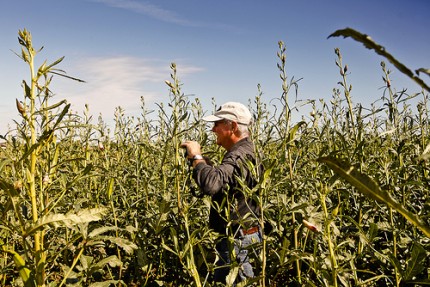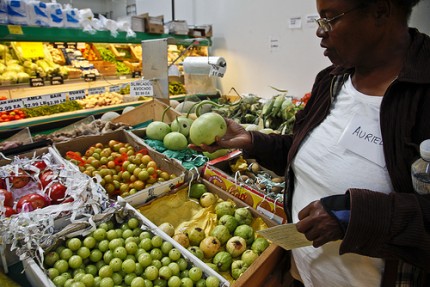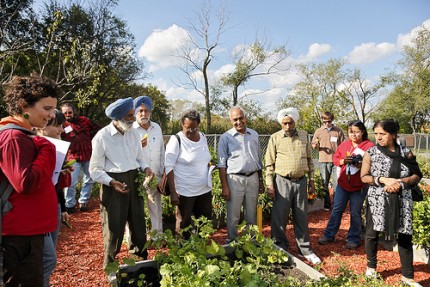City to Country Virtual Tour #2: Growing World Crops Close to Home
Posted: June 18, 2012
Categories: City to Country / Growing Good Food Ideas / News from Sustain Ontario / Virtual Tours
by Emily Martyn, Toronto Green Community

World Crops, staples in cuisines around the world, are not often grown here in Ontario. On September 22, through Sustain Ontario’s ‘city to country’ tour, I had the opportunity to see firsthand how plants like okra, bitter melon and yard long beans are beginning to appear in local agriculture and markets. This one-day event took city folk out to visit a variety of food projects within and beyond the GTA.
Participants piled into a school bus with Emily van Halem and Peter Mitchell, organizers the World Crops Project, and our guides for the day. By growing these crops locally, the project is a key part of making local food relevant to diverse groups. The project started out with research at Vineland Research and Innovation Centre in Niagara, and is now providing farmers and community gardeners with crops to experiment with large-scale cultivation.
We first visited the Collins Farm, an operation focused on bunching crops – radishes, carrots and herbs. Okra, Asian eggplant and yard long beans were growing on a test basis, with the predominantly South Asian staff taking the produce home. Other than some troubles with the yard-long beans, the crops seemed to be flourishing. Joan, the owner at Collins Farm, identified some incompatibilities with the harvesting and storage processes on site; world crops require more frequent harvest and less chilling temperatures than the roots they generally grow. However, she was quick to emphasize the operation had excelled in the labour-intensive world of bunching crops because it remains an untapped market.
After sharing okra recipes, we headed back on the bus with our newly energized bus driver, Roberta, who had decided to take part in the tour. We were off to Golden Groceries in Brampton, a family-owned South Asian grocery store which sells some of the world crops grown at Vineland.
We were welcomed into the boardroom with samosas and Indian desserts, and settled in to discuss the details of getting world crops to consumers. Satnam, the manager, explained how customers’ discerning tastes could act as both support and a barrier to the sales of world crops – choosing the freshest looking produce (generally the Ontario grown varieties), but remaining suspicious of discrepancies with food back home. Thus, larger okra, smaller eggplants and crooked carrots are left behind in favour of traditional looking imports. Encouraged by the support for the fresh food, it now seems to be a matter of familiarizing customers with local varieties.
The final two stops looked at semi-urban agricultural projects where growers were trying out world crops. First up, the Sahara Seniors Garden, a program supported by Punjabi Community Health Services. This vibrant garden is run by a group of generous and knowledgeable seniors, who showed us around and filled us with fresh peppers, chai and homemade pakoras. Their crops consisted of a range of eggplants, peppers, squash and herbs, most of which the gardeners consumed, with some allocated beds for donation to the local food bank.
We finished our tour at Farmstart’s McVean Incubation farm in Brampton, visiting a farmer couple trying out world crops on a 3.5 acre area of the incubator farm. Margaret Zondo and Rodney Garnes have been growing at McVean since 2008 under the banner Southern Horizons and sell their products, including homemade hot pepper sauce and green marinade, at The Stop’s Green Barn and Toronto Botanical Gardens farmers’ markets.
As newcomers to Canada themselves, Margaret and Rodney got into farming due to a desire to make traditional foods available in Canada, making the world crops project a natural fit. Showing us the productive and diverse fields, Margaret explained how direct marketing of the farmers’ market is an integral part of getting world crops to new groups. Speaking directly to customers allows for explanations of unfamiliar crops and recommended preparations.
So when it comes to world crops, the growing is easy; the distribution and education is what requires creative thinking. By the end of the day we were all encouraged about the potential of locally grown world crops. With a ready demand and growing supply, we have to continue building on the creative ways to bring these foods to the public.



